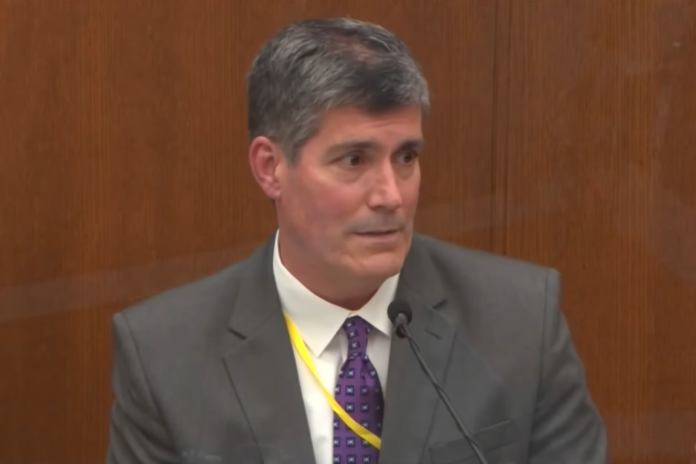
Friday, April 9
Dr. Andrew Baker, the medical examiner who conducted George Floyd’s autopsy, was the second witness for the prosecution Friday afternoon. He testified that George Floyd’s brain was not “deprived of blood or oxygen.”
Dr. Andrew Baker says medical examiners do not see pressure to the back of the neck in cases of asphyxiation or strangulation. pic.twitter.com/Ysaa37KNtc
— Alpha News (@AlphaNewsMN) April 9, 2021
Medical examiner testifies that it appears Chauvin's knee was on George Floyd's back and not on his neck. Even if it was on Floyd's neck, blocking an artery, Floyd's other artery "would continue to supply blood to the brain," he says. pic.twitter.com/BbDm4Y5bRH
— Alpha News (@AlphaNewsMN) April 9, 2021
Medical examiner Dr. Andrew Baker says George Floyd had "very severe underlying heart disease" and that his "heart weighed more than it should."
Because of these "heart conditions," the law enforcement subdual was "more than Mr. Floyd could take," he adds. #DerekChauvinTrial pic.twitter.com/ZkYA1QUjjU
— Alpha News (@AlphaNewsMN) April 9, 2021
Dr. Andrew Baker, the medical examiner who conducted George Floyd's autopsy, says during testimony that George Floyd's brain was not "deprived of blood or oxygen." pic.twitter.com/xMi8Edvgxc
— Alpha News (@AlphaNewsMN) April 9, 2021
The state’s first witness Friday morning was Dr. Lindsey Thomas, a forensic pathologist. She reviewed George Floyd’s death certificate on the stand and said the mechanism of death was low oxygen, which was due to law enforcement’s “subdual, restraint, and compression” of George Floyd.
“The activities of the law enforcement officers resulted in Mr. Floyd’s death,” Thomas said.
Prosecution is not happy with the defense counsel's line of questioning. pic.twitter.com/Syf8zncpDW
— Alpha News (@AlphaNewsMN) April 9, 2021
Dr. Lindsey Thomas testifies that the levels of fetanyl and methamphetamine found in George Floyd's system could constitute an overdose, in the absence of other factors like heart problems and struggles with police.#DerekChauvinTrial pic.twitter.com/vuelVtFefL
— Alpha News (@AlphaNewsMN) April 9, 2021
Defense counsel Eric Nelson points out that a study of "actual police encounters" shows that Canadian police placed 3,000 people in the prone position, and none died. pic.twitter.com/DtqwU4VW7C
— Alpha News (@AlphaNewsMN) April 9, 2021
Dr. Lindsey Thomas, forensic pathologist, said she would conclude George Floyd died of heart disease if the police and drugs were removed from the equation. She agrees Floyd's heart disease is a "potential cause of death." #DerekChauvinTrial pic.twitter.com/IQYIuTkp61
— Alpha News (@AlphaNewsMN) April 9, 2021
Dr. Lindsey Thomas explains what officers' "subdual, restraint, and compression" of George Floyd looked like. "The activities of the law enforcement officers resulted in Mr. Floyd's death," she says. pic.twitter.com/UZDDhK0J8j
— Alpha News (@AlphaNewsMN) April 9, 2021
Thursday, April 8
The second witness for the prosecution was Daniel Isenschmid, a forensic toxicologist at NMS labs in Pennsylvania. He testified that samples of George Floyd’s blood produced the presence of both fentanyl and methamphetamine, as well as traces of other substances too low to be reported.
Isenschmid testified on cross examination that opioids bought on the street, which are not necessarily created in a controlled environment, could have any concentration of fentanyl. “Any single incident could cause an adverse reaction,” regardless of tolerance to fentanyl, defense attorney Eric Nelson said, to which Isenschmid agreed.
Daniel Isenschmid agrees on cross examination that opioids bought on the street, which are not necessarily created in a controlled environment, could have any concentration of fentanyl: "You don't know from pill to pill." pic.twitter.com/1LtzLmwM1M
— Alpha News (@AlphaNewsMN) April 8, 2021
Next witness for the state Daniel Isenschmid, forensic toxicologist, says samples of George Floyd's blood produced the presence of both fentanyl and methamphetamine. pic.twitter.com/Eg6Z919QwI
— Alpha News (@AlphaNewsMN) April 8, 2021
The state continued calling witnesses Thursday morning, the first being Dr. Martin Tobin, a physician who specializes in pulmonology — the study of the lungs and respiratory system — and critical care medicine. Tobin testified that, in his professional opinion, George Floyd died “from a low level of oxygen.” He agreed that fentanyl “can cause death as a result of low oxygen to the brain.”
Dr. Martin Tobin testifies that fentanyl can cause death, "in part," as a result of low oxygen to the brain. pic.twitter.com/4S3JOAiLHm
— Alpha News (@AlphaNewsMN) April 8, 2021
Witness Dr. Martin Tobin calculates George Floyd's respiratory rate from video evidence and determines it to be "normal," testifying that fentanyl did not affect George Floyd's breathing immediately before he went unconscious. pic.twitter.com/EOIW68aX20
— Alpha News (@AlphaNewsMN) April 8, 2021
Witness for the state Dr. Martin Tobin, a physician who specializes in the study of the lungs, testifies that George Floyd died "from a low level of oxygen." pic.twitter.com/eLuDv1ArW3
— Alpha News (@AlphaNewsMN) April 8, 2021
Wednesday, April 7
Mckenzie Anderson, a forensic scientist with the BCA, said after testing a small white pill found behind the passenger seat of the squad car, she determined the DNA matched the DNA profile of George Floyd.
Witness Mckenzie Anderson, a forensic scientist with the BCA, said after testing a small white pill found behind the passenger seat of the squad car, she determined the DNA matched that of George Floyd's. pic.twitter.com/Nmef8oNtpS
— Alpha News (@AlphaNewsMN) April 7, 2021
The second witness for the day was James Reyerson, special agent with the Bureau of Criminal Apprehension and the primary case agent in this case. During cross examination, Reyerson was shown body camera footage in which George Floyd can seemingly be heard saying, “I ate too many drugs.” Reyerson agreed that is what is heard in the video.
Prosecution showed Reyerson the same video, and Reyerson said it actually sounds like Floyd is saying, "I ain't do no drugs." pic.twitter.com/5lVRspM9xY
— Alpha News (@AlphaNewsMN) April 7, 2021
James Reyerson is shown surveillance footage of Morries Hall, who appears to notice the police car across the street, then reach into his backpack and throw something. pic.twitter.com/GHR0QDIDbL
— Alpha News (@AlphaNewsMN) April 7, 2021
The court continued Wednesday morning with the testimony of LAPD Sgt. Jody Stiger, expert witness on police use of force for the prosecution. Stiger testified that George Floyd’s “active resistance” justified the use of force by the officers in their attempts to get Floyd into the squad car.
LAPD Sgt. Jody Stiger testifies that the technique of placing a knee between a suspect's shoulder blades at the base of the neck is commonly trained in groundwork and handcuffing in "every department" he is familiar with. pic.twitter.com/jIG83QvAjj
— Alpha News (@AlphaNewsMN) April 7, 2021
LAPD Sgt. Jody Stiger testifies that George Floyd's "active resistance" justified the use of force by the officers in their attempts to get Floyd into the squad car. pic.twitter.com/P1uYoEQQhw
— Alpha News (@AlphaNewsMN) April 7, 2021
Tuesday, April 6
Nicole Mackenzie, MPD officer and medical support coordinator, says bystanders do "occasionally attack EMS crews" so "getting out of the situation is the best way to defuse it." pic.twitter.com/8lsZqj8Ndm
— Alpha News (@AlphaNewsMN) April 6, 2021
Minneapolis police Lt. Johnny Mercil, a use of force trainer for the department, testified that photos from body cameras worn by the officers on scene appear to show Derek Chauvin’s knee placed between George Floyd’s shoulder blades, and does not appear to be a “neck restraint.”
Witness for the state MPD Lt. Johnny Mercil, a trainer in the use of force division, testifies that it appears Derek Chauvin's knee was placed between George Floyd's shoulder blades. It does not appear to be a "neck restraint." pic.twitter.com/uubw0g9vhn
— Alpha News (@AlphaNewsMN) April 6, 2021
Lt. Johnny Mercil, a trainer in the use of force division, said this afternoon that he has held down a suspect until EMS arrived. #DerekChauvinTrial pic.twitter.com/B8d6MIousL
— Alpha News (@AlphaNewsMN) April 6, 2021
Lt. Johnny Mercil testifies in cross-examination that the position of an officer's knee and shin across a neck and onto a shoulder blade is a trained position in the department. pic.twitter.com/SWaXHIZ3Fs
— Alpha News (@AlphaNewsMN) April 6, 2021
The court began the day by discussing Morries Hall’s intention to invoke his Fifth Amendment right against self-incrimination. Hall was with Floyd on the day of his death and allegedly sold him drugs in the past. He is currently in prison and appeared in court remotely Tuesday morning with his attorney.
THIS MORNING: Attorney for Morries Hall, who was with George Floyd on the day he died and allegedly sold him drugs, explains that Hall is invoking his 5th Amendment rights to avoid exposure to a 3rd degree murder charge. pic.twitter.com/DOZcvgNUxT
— Alpha News (@AlphaNewsMN) April 6, 2021
Judge Peter Cahill hasn’t issued a final ruling, but indicated that he’s inclined to require Hall to testify on a very narrow subject matter. For most topics, Cahill said Hall has a legitimate Fifth Amendment right.
Monday, April 5
One of the most highly-anticipated moments of the trial began Monday when Minneapolis Police Chief Medaria Arradondo took the stand for the state.
Defense counsel Eric Nelson discusses the concept of "camera perspective bias." Arradondo agrees that Chauvin's knee appears to be on Floyd's neck in the bystander video, but appears to be on his "shoulder blade" in the body-cam video. (Content may be disturbing to some viewers) pic.twitter.com/WxURy8nytS
— Alpha News (@AlphaNewsMN) April 5, 2021
Minneapolis Police Chief Medaria Arradondo testifies against Derek Chauvin and says his restraint of George Floyd was not in line with department policy. #DerekChauvinTrial pic.twitter.com/Qc5oqvO5wc
— Alpha News (@AlphaNewsMN) April 5, 2021
Minneapolis Police Chief Medaria Arradondo says neck restraints and chokeholds were "taught and authorized" at the time of George Floyd's death. #DerekChauvinTrial pic.twitter.com/62g7k8IomT
— Alpha News (@AlphaNewsMN) April 5, 2021
The first witness to testify Monday morning was Dr. Bradford Wankhede Langenfeld, a physician at Hennepin County Medical Center who cared for George Floyd. At the time, Langenfeld believed oxygen deficiency, or asphyxiation, caused Floyd’s fatal cardiac arrest.
Dr. Bradford Wankhedelangenfeld was the first to testify this morning. He is a doctor at HCMC and cared for George Floyd. He said he believed at the time that oxygen deficiency caused Floyd's cardiac arrest. #DerekChauvinTrial pic.twitter.com/RsLoHbnWFn
— Alpha News (@AlphaNewsMN) April 5, 2021

















